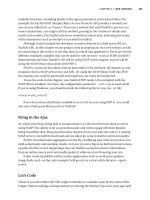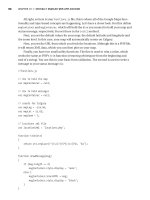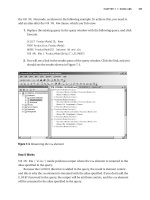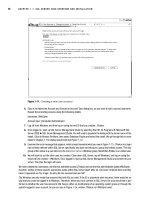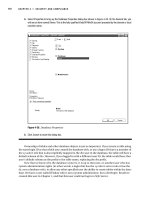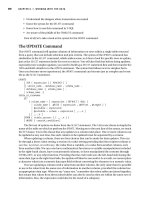Beginning Java SE 6 Platform From Novice to Professional phần 8 pps
Bạn đang xem bản rút gọn của tài liệu. Xem và tải ngay bản đầy đủ của tài liệu tại đây (585.38 KB, 51 trang )
Listing 9-15. TempConverter.rb
# TempConverter.rb
class TempConverter
def c2f(degrees)
degrees*9.0/5.0+32
end
def f2c(degrees)
(degrees-32)*5.0/9.0
end
end
def getTempConverter
TempConverter.new
end
The application uses ScriptEngineManager’s getEngineByName() method and the jruby
short name to access JRuby’s script engine. It loads and evaluates TempConverter.rb,
invokes
getTempConverter() to obtain a TempConverter instance, and uses this instance
to invoke
TempConverter’s methods. The application is presented in Listing 9-16.
Listing 9-16. WorkingWithJRuby.java
// WorkingWithJRuby.java
import java.io.*;
import javax.script.*;
public class WorkingWithJRuby
{
public static void main (String [] args) throws Exception
{
ScriptEngineManager manager = new ScriptEngineManager ();
// The JRuby script engine is accessed via the jruby short name.
ScriptEngine engine = manager.getEngineByName ("jruby");
// Evaluate TempConverter.rb to generate intermediate code.
CHAPTER 9 ■ SCRIPTING334
830-X CH09.qxd 9/20/07 2:08 PM Page 334
engine.eval (new BufferedReader (new FileReader ("TempConverter.rb")));
Invocable invocable = (Invocable) engine;
Object tempconverter = invocable.invokeFunction ("getTempConverter");
double degreesCelsius;
degreesCelsius = (Double) invocable.invokeMethod (tempconverter, "f2c",
98.6);
System.out.println ("98.6 degrees Fahrenheit = "+degreesCelsius+
" degrees Celsius");
double degreesFahrenheit;
degreesFahrenheit = (Double) invocable.invokeMethod (tempconverter,
"c2f", 100.0);
System.out.println ("100.0 degrees Celsius = "+degreesFahrenheit+
" degrees Fahrenheit");
}
}
To run this application, you will need to add jruby-engine.jar and jruby.jar (located
in the JRuby home directory’s
lib subdirectory) to the classpath (via either the classpath
environment variable or the
java tool’s -cp option). Here’s an example for the Windows
platform:
java -cp c:\jruby-1.0\lib\jruby.jar;c:\jruby-1.0\lib\jruby-engine.jar;.➥
WorkingWithJRuby
You should observe the following output:
98.6 degrees Fahrenheit = 37.0 degrees Celsius
100.0 degrees Celsius = 212.0 degrees Fahrenheit
If you want to play with JRuby via
jrunscript, you will need to first copy all JAR files
(including
jruby-engine.jar) from the JRuby home directory’s lib subdirectory to the
JRE’s
lib\ext directory (or lib/ext, from the Unix perspective). Although you might be
able to get away with copying only
jruby.jar and a few other JARs, you will most likely
receive a
NoClassDefFoundError if a needed JAR file is missing when you try to access the
script engine. After copying these files,
jrunscript -l jruby will take you to jrunscript’s
jruby> prompt. From there, you can load and execute a Ruby script file, as in load
"demo.rb"
. If you choose to copy all JAR files to the JRE’s extensions directory, you will
no longer need to add
jruby-engine.jar and jruby.jar to the classpath before running
WorkingWithJRuby.
CHAPTER 9 ■ SCRIPTING 335
830-X CH09.qxd 9/20/07 2:08 PM Page 335
JavaFX Script and the Scripting API
At its May 2007 JavaOne Conference, Sun introduced JavaFX, a family of products for
creating rich Internet applications. Check out Wikipedia’s JavaFX entry (
http://en.
wikipedia.org/wiki/JavaFX) for a brief introduction to JavaFX. This product family’s
scripting-language member is JavaFX Script, which is based on Chris Oliver’s F3
(Form Follows Function) language.
■Note Chris Oliver’s “F3” blog entry ( introduces F3.
Also, Wikipedia’s “JavaFX Script” entry (
introduces
JavaFX Script.
JavaFX Script is maintained by java.net’s OpenJFX project. According to this project’s
home page (
/>Project OpenJFX is a project of the OpenJFX community for sharing early versions
of the JavaFX Script language and for collaborating on its development. In the
future, the JavaFX Script code will be open sourced. The governance, licensing, and
community models will be worked out as the project evolves.
For the latest information on the OpenJFX project, check out the home page’s
“What’s New” section.
■Caution Because Project OpenJFX is evolving, it is possible that some of this chapter’s JavaFX Script
content will no longer be correct when this book reaches bookstores.
The OpenJFX project’s home page has this to say about the language: “JavaFX Script
is a declarative, statically typed programming language. It has first-class functions,
declarative syntax, list-comprehensions, and incremental dependency-based evalua-
tion.” First-class functions are functions that are treated as values. They might be used as
function arguments, for example. Planet JFX’s FAQ page (
/>defines declarative syntax, list comprehensions, and incremental dependency-based
evaluation.
CHAPTER 9 ■ SCRIPTING336
830-X CH09.qxd 9/20/07 2:08 PM Page 336
The OpenJFX project’s home page goes on to say that JavaFX Script can make direct
calls to the Java APIs that are located on the same platform. Also, its statically typed
nature means that JavaFX Script “has the same code structuring, reuse, and encapsula-
tion features (such as packages, classes, inheritance, and separate compilation and
deployment units) [as Java] that make it possible to create and maintain very large pro-
grams using Java technology.” Collectively, JavaFX Script’s features allow you to quickly
build “rich and compelling UIs leveraging Java Swing, Java 2D and Java 3D.” For a detailed
guide to the JavaFX Script language, check out OpenJFX’s The JavaFX Script Program-
ming Language page (
/>■Note Although JavaFX Script is statically typed, types can be omitted in many places because JavaFX
Script can infer types from the contexts in which they are used. For an example, check out Sundar Athijegan-
nathan’s “JavaScript, JSON and JavaFX Script” blog entry (
/>entry/javascript_json_and_javafx_script).
The Downloads section of OpenJFX’s home page provides a “via tar.gz or zip file” link
that takes you to a page (
/>where you can download the latest JavaFX script runtime, library source, and demos as
either a ZIP file or a TAR file. When this chapter was written,
OpenJFX-200707201531.tar.gz
and OpenJFX-200707201531.zip were the latest files. Unarchiving this ZIP file results in an
openjfx-200707201531 home directory, whose trunk subdirectory contains various useful
subdirectories.
■Tip The Downloads section of OpenJFX’s home page also provides links to plug-ins that let you work with
JavaFX Script from within NetBeans IDE 5.5 and 6.0, and Eclipse 3.2. You might want to install the appropri-
ate plug-in, so that you can explore JavaFX Script with your favorite IDE.
The
trunk directory provides a demos subdirectory which contains programs that
demonstrate the usefulness of JavaFX Script. To play with these demonstration programs,
change to
demos directory’s demo subdirectory and launch demo.bat or demo.sh. After a
moment, you should see a JavaFX Demos window that presents a JavaFX Demos tab with
a list of demo names. Figure 9-3 shows the JavaFX Canvas Tutorial demo’s introductory
page.
CHAPTER 9 ■ SCRIPTING 337
830-X CH09.qxd 9/20/07 2:08 PM Page 337
Figure 9-3. JavaFX Canvas Tutorial lets you interactively explore JavaFX Script.
The
trunk directory also provides a lib subdirectory that contains Filters.jar,
javafxrt.jar, and swing-layout.jar. These JAR files collectively implement JavaFX Script.
javafxrt.jar contains JavaFXScriptEngine.class and JavaFXScriptEngineFactory.class,
which serve as JavaFX Script’s script engine. You can copy these JAR files to the JRE’s
extensions directory to access JavaFX Script from
jrunscript (invoke jrunscript -l FX,
which takes you to this tool’s
FX> prompt), but you will not be able to accomplish any-
thing. JavaFX Script’s script engine keeps referring to
script error: Invalid binding name
'javax.script.argv'. Must be of the form 'beanName:javaTypeFQN'
. Obviously, jrunscript
needs additional work before it can access JavaFX Script.
Fortunately, you can access JavaFX Script’s script engine via the Scripting API. To
prove this, I have prepared an example that demonstrates running a script via a Java
application. This script presents a window that is centered on the screen. On a pale yel-
low background, it displays bluish text that is gradient-filled, noisy, glowing, and slightly
blurred. Listing 9-17 presents this script.
CHAPTER 9 ■ SCRIPTING338
830-X CH09.qxd 9/20/07 2:08 PM Page 338
Listing 9-17. demo.fx
// demo.fx
import javafx.ui.*;
import javafx.ui.canvas.*;
import javafx.ui.filter.*;
Frame
{
width: 650
height: 150
title: "demo.fx"
background: lightgoldenrodyellow
centerOnScreen: true
content: Canvas
{
content: Text
{
x: 15
y: 20
content: "{msg:<<java.lang.String>>}"
font: Font { face: VERDANA, style: [ITALIC, BOLD], size: 80 }
fill: LinearGradient
{
x1: 0, y1: 0, x2: 0, y2: 1
stops:
[
Stop
{
offset: 0
color: blue
},
Stop
{
offset: 0.5
color: dodgerblue
},
Stop
CHAPTER 9 ■ SCRIPTING 339
830-X CH09.qxd 9/20/07 2:08 PM Page 339
{
offset: 1
color: blue
}
]
}
filter: [MotionBlur { distance: 10.5 }, Glow {amount: 0.15},
Noise {monochrome: false, distribution: 0}]
}
}
visible: true
}
Listing 9-17 demonstrates JavaFX Script’s declarative coding style, where values are
assigned to GUI component properties (
650 is assigned to the frame window’s width
property, for example) instead of invoking methods for this purpose. The
{msg:<<java.lang.String>>} text is a placeholder for a String-based value, which is
displayed in the window, and obtained from the application shown in Listing 9-18.
Listing 9-18. WorkingWithJavaFXScript.java
// WorkingWithJavaFXScript.java
import java.awt.*;
import java.io.*;
import javax.script.*;
public class WorkingWithJavaFXScript
{
public static void main (String [] args)
{
ScriptEngineManager manager = new ScriptEngineManager ();
// The JavaFX Script script engine is accessed via the FX short name.
final ScriptEngine engine = manager.getEngineByName ("FX");
engine.put ("msg:java.lang.String", "JavaFX Script");
CHAPTER 9 ■ SCRIPTING340
830-X CH09.qxd 9/20/07 2:08 PM Page 340
Runnable r = new Runnable ()
{
public void run ()
{
try
{
System.out.println ("EDT running: "+
EventQueue.isDispatchThread ());
engine.eval (new BufferedReader (new FileReader ("demo.fx")));
}
catch (Exception e)
{
e.printStackTrace ();
}
}
};
EventQueue.invokeLater (r);
}
}
After obtaining JavaFX Script’s script engine via the engine’s FX short name, the appli-
cation uses
engine.put ("msg:java.lang.String", "JavaFX Script"); to pass a string value
(to be displayed in the script’s frame window) to the script. The script is then evaluated
on the event-dispatching thread, because a Swing GUI is being created.
Run this application with
Filters.jar, javafxrt.jar, and swing-layout.jar as part of
the classpath. For example, assuming that these JAR files are located in
\javafx, java
-cp \javafx\Filters.jar;\javafx\swing-layout.jar;\javafx\javafxrt.jar;.
WorkingWithJavaFXScript runs the application on a Windows platform. The application
and script work together to generate the window that appears in Figure 9-4.
Figure 9-4. This GUI created with JavaFX Script is initially centered on the screen.
Furthermore, three messages are sent to the standard output device. The first mes-
sage reports that the event-dispatching thread is running. The next two messages identify
CHAPTER 9 ■ SCRIPTING 341
830-X CH09.qxd 9/20/07 2:08 PM Page 341
the thread that JavaFX Script’s internal compiler uses to compile a script into intermedi-
ate code (to boost performance), and the amount of time that it takes to compile the
script.
Because JVM class files offer better performance than intermediate code, java.net is
hosting the OpenJFX Compiler project. According to this project’s home page (
https://
openjfx-compiler.dev.java.net/), the goal is to “focus on creating a JavaFX compiler to
translate JavaFX scripts into JVM class files (bytecode).” Also, the new compiler will
extend the standard Java compiler.
■Note Chris Oliver provides a performance boost benchmark for an early version of this new compiler
via his “First steps with the JavaFX Compiler” blog entry (
/>entry/first_steps_with_the_javafx).
Summary
Java SE 6 introduces the Scripting API so that servlets, applications, and other kinds of
Java programs can work with Ruby, PHP, JavaScript, and other scripting languages.
The Scripting API was developed under JSR 223 and is provided in the
javax.script
package. Java SE 6 also includes the Rhino script engine.
Before you can benefit from this API, you need to master its fundamentals, including
how to perform the following tasks:
• Obtain script engines from factories via the script engine manager
• Evaluate scripts
• Interact with Java classes and interfaces from scripts
• Communicate with scripts via script variables
• Use bindings, scopes, and script contexts
• Generate scripts from macros
• Compile scripts
• Invoke global, object member, and interface-implementing functions
• Use
jrunscript
CHAPTER 9 ■ SCRIPTING342
830-X CH09.qxd 9/20/07 2:08 PM Page 342
Integrating Rhino-based JavaScript into the JEditorPane component is a good exam-
ple of what you can accomplish with the Scripting API. The resulting
ScriptedEditorPane
component lets you present an HTML document augmented with JavaScript so that the
user can dynamically change the colors of the document’s links when the mouse pointer
moves over those links.
Although Rhino-based JavaScript is useful and fun to play with (especially via
jrunscript), you will want to try the Scripting API with other scripting languages. This
chapter presented examples of using the API with JRuby and JavaFX Script.
Test Your Understanding
How well do you understand Java SE 6’s new Scripting API? Test your understanding by
answering the following questions and performing the following exercises. (The answers
are presented in Appendix D.)
1. What is the name of the package assigned to the Scripting API?
2. What is the difference between the
Compilable interface and the CompiledScript
abstract class?
3. Which scripting language is associated with Java SE 6’s Rhino-based script engine?
4. What is the difference between
ScriptEngineFactory’s getEngineName() and
getNames() methods?
5. What does it mean for a script engine to exhibit the
MULTITHREADED threading
behavior?
6. Which of
ScriptEngineManager’s three “getEngine” methods would be appropriate
for obtaining a script engine after selecting the name of a script file via a dialog
box?
7. How many
eval() methods does ScriptEngine offer for evaluating scripts?
8. Why does the Rhino-based script engine not import the
java.lang package by
default?
9. What is the problem with
importPackage() and importClass(), and how does Rhino
overcome this problem?
10. How does a Java program communicate with a script?
11. How does
jrunscript make command-line arguments available to a script?
CHAPTER 9 ■ SCRIPTING 343
830-X CH09.qxd 9/20/07 2:08 PM Page 343
12. What is a bindings object?
13. What is the difference between engine scope and global scope?
14. Although a program will have occasion to change a script engine’s engine bind-
ings, it is rather pointless to change the engine’s global bindings. Why does
ScriptEngine provide a setBindings(Bindings bindings, int scope) method that
allows the global bindings to be replaced?
15. What does a script context do?
16. What is the difference between
eval(String script, ScriptContext context) and
eval(String script, Bindings n)?
17. What is the purpose of the
context script variable? How would you output this
variable’s value in Rhino-based JavaScript and JRuby?
18. What is wrong with
getOutputStatement()?
19. How do you compile a script?
20. What benefits does the
Invocable interface provide?
21. What is
jrunscript?
22. How would you discover the implementations for the
jlist(), jmap(), and
JSInvoker() functions?
23. What is
JSAdapter?
24. If you were to modify
demo.html’s setColor(color) function to print document.
linkcolor’s value before and after setting this property to the color argument
(as in
function setColor(color) { println ("Before = "+document.linkcolor);
document.linkcolor = color; println ("After = "+document.linkcolor); }
), you
would notice that the first time you move the mouse pointer over either of this
document’s two links, you get the output
Before = java.awt.Color[r=0,g=0,b=0].
This output indicates that
document.linkcolor’s initial value is black (instead of
blue, assuming the default setting). Why? How would you fix this so that the out-
put is
Before = java.awt.Color[r=0,g=0,b=255] (again, assuming the default blue
style sheet setting)? Note that you will need to research the editor pane compo-
nent to answer this question.
25. Modify
WorkingWithJRuby (Listing 9-16) to invoke WorkingWithJavaFXScript
(Listing 9-18). In the modified version, a Java program evaluates a Ruby script,
which executes a Java program, which evaluates a JavaFX Script-based script.
CHAPTER 9 ■ SCRIPTING344
830-X CH09.qxd 9/20/07 2:08 PM Page 344
Security and Web Services
The JDK documentation itemizes Java SE 6’s many security enhancements on its Java 6
Security Enhancements page (
/>security/enhancements.html). This chapter discusses two new security APIs supplied with
Java SE 6 for dealing with smart cards and digital signatures.
Prior to the release of Java SE 6, working with web services involved the use of enter-
prise Java APIs. Because Java SE 6 introduces several new web service and web-service-
oriented APIs, such as the XML Digital Signature APIs, it is now considerably easier to
develop web services and Java applications that interact with web services. This chapter
describes Java SE 6’s support for web services.
The following topics are covered in this chapter:
• Smart Card I/O API
• XML Digital Signature APIs
• Web services stack
■Note Two security topics have been covered in previous chapters. Chapter 1 mentioned an enhancement
involving Java SE 6’s
jarsigner, keytool, and kinit security tools. (Appendix B presents new jarsigner
and keytool options.) Chapter 8 discussed SPNEGO HTTP authentication from the networking perspective.
Smart Card I/O API
Years ago, while working for a small software development company, I encountered an
interesting device known as a smart card. As part of my job, I created a Java API to interact
with smart cards via a smart card reader. This API detected card insertions and removals,
and provided the means to acquire a user’s credentials from an inserted smart card.
■Note Check out Wikipedia’s Smart card entry ( for an
introduction to smart cards.
345
CHAPTER 10
830-X CH10.qxd 9/18/07 9:49 PM Page 345
Because the card reader’s software consisted of Windows dynamic link libraries
(DLLs), I used the Java Native Interface (JNI) to provide the bridge between Java and the
native code that interacted with these DLLs—a messy business. My job would have been
much easier if the version of Java that I worked with had provided an API for communi-
cating with smart cards. Fortunately, Sun has finally addressed this situation by providing
the Smart Card I/O API and the SunPCSC security provider in its Java SE 6 reference
implementation.
■Caution Because the Smart Card I/O API and SunPCSC provider are not part of the Java SE 6 specifica-
tion, they are only guaranteed to be available as part of Sun’s reference implementation.
The Smart Card I/O API lets a Java application communicate with applications run-
ning on a smart card by exchanging ISO/IEC 7816-4 Application Protocol Data Units
(APDUs). The SunPCSC security provider lets the API access the underlying platform’s
Personal Computer/Smart Card (PC/SC) stack (if available). SunPCSC accesses this stack
via the
libpcsclite.so library on Solaris and Linux platforms. On Windows platforms,
SunPCSC accesses the stack via the
winscard.dll library.
The Smart Card I/O API was developed according to JSR 268: Java Smart Card I/O API
(
Although this JSR identifies javax.io.smartcard as
the API’s proposed package name, the API’s official package name is
javax.smartcardio.
Table 10-1 describes this package’s 12 classes, which are fully documented in the JDK at
(Although these
classes are documented in Sun’s JDK documentation, they are not part of the Java SE 6
specification, and are only guaranteed to be part of Sun’s reference implementation.)
Table 10-1. javax.smartcardio Classes
Class Description
ATR Stores a smart card’s answer-to-reset bytes. A smart card sends these
bytes to a terminal (a card reader slot) when the card is inserted into
the terminal (which powers up the card), or when a command is sent to
the terminal to explicitly reset the card. The answer-to-reset bytes are
used to establish the basis for a communications session. If you are
interested in the format of these bytes, see “Answer to Reset Explained”
( />Card Describes a smart card with an associated connection. A Card is
obtained by acquiring a CardTerminal instance and using this instance
to invoke CardTerminal’s public abstract Card connect(String
protocol) method with the specified protocol.
CHAPTER 10 ■ SECURITY AND WEB SERVICES346
830-X CH10.qxd 9/18/07 9:49 PM Page 346
Class Description
CardChannel Describes a logical channel to a smart card, which is used to exchange
APDUs with the card. A CardChannel is obtained by invoking either of
Card’s public abstract CardChannel getBasicChannel() or public
abstract CardChannel openLogicalChannel() methods via the Card
instance.
CardException Thrown when an error occurs during communication with the smart
card or a smart card stack. In the future, it is possible that new smart
card stacks will be introduced. PC/SC is the only stack currently
available from Sun’s reference implementation.
CardNotPresentException Thrown when an application tries to establish a connection with a
terminal and a card is not present in the terminal.
CardPermission Describes the permission for smart card operations. This class
identifies the name of the terminal to which the permission applies
and the set of actions (connect, reset, and so on) that is valid for the
terminal.
CardTerminal Describes a card reader slot. A CardTerminal is obtained by invoking
either of the CardTerminals class’s list() methods and choosing a list
entry, or by invoking the CardTerminals class’s public CardTerminal
getTerminal(String name) method with the vendor-specific name of
the terminal.
CardTerminals Describes the set of terminals supported by an instance of
TerminalFactory. An application uses CardTerminals to enumerate
available card terminals, obtain a specific card terminal, or wait for a
card to be inserted or removed. The inner State enumeration
describes various card terminal state constants, such as
CardTerminals.State.CARD_PRESENT. A state constant is passed to
CardTerminals’s public abstract List<CardTerminal>
list(CardTerminals.State state) method to return a list of all card
terminals for which this state was detected during the most recent
call to one of CardTerminals’s two waitForChange() methods.
CommandAPDU Stores an ISO/IEC 7816-4-structured command APDU, which consists
of a 4-byte header (identifying an instruction’s class, code, and
parameters), followed by an optional body of variable length.
ResponseAPDU Stores an ISO/IEC 7816-4-structured response APDU, which consists of
an optional body followed by a 2-byte trailer. The trailer provides status
information about the card’s processing state following the command
APDU’s execution.
TerminalFactory Entry point into the Smart Card I/O API. An application obtains a
TerminalFactory instance by invoking this class’s public static
TerminalFactory getDefault() method to return the default terminal
factory (which is always available, but might not provide any
terminals). Alternatively, the application can call any of this class’s
three getInstance() methods to obtain a terminal factory based on
some combination of a smart card stack type and a java.security.
Provider implementation.
TerminalFactorySpi Describes the service provider interface for introducing new smart
card-oriented security providers. Applications do not interact with this
class directly.
CHAPTER 10 ■ SECURITY AND WEB SERVICES 347
830-X CH10.qxd 9/18/07 9:49 PM Page 347
While writing this chapter, I did not have access to a smart card or a reader, which
made it impossible to create a significant example. Instead, I opted for a limited example
that demonstrates how to obtain the default terminal factory and a factory for the PC/SC
stack. The example also shows how to enumerate a factory’s card terminals. Listing 10-1
presents the source code.
Listing 10-1. Terminals.java
// Terminals.java
import java.util.*;
import javax.smartcardio.*;
public class Terminals
{
public static void main (String [] args) throws Exception
{
TerminalFactory factory = TerminalFactory.getDefault ();
System.out.println ("Default factory: "+factory);
dumpTerminals (factory);
factory = TerminalFactory.getInstance ("PC/SC", null);
System.out.println ("PC/SC factory: "+factory);
dumpTerminals (factory);
}
static void dumpTerminals (TerminalFactory factory) throws Exception
{
List<CardTerminal> terminals = factory.terminals ().list ();
for (CardTerminal terminal: terminals)
System.out.println (terminal);
}
}
After running Terminals on my Windows platform, the first line of output was as
follows:
Default factory: TerminalFactory for type None from provider None
CHAPTER 10 ■ SECURITY AND WEB SERVICES348
830-X CH10.qxd 9/18/07 9:49 PM Page 348
I also observed output related to a java.security.NoSuchAlgorithmException, which
was thrown from
TerminalFactory.getInstance("PC/SC", null). I believe this exception
was thrown because a card reader device was not present on my platform.
XML Digital Signature APIs
Web-based business transactions commonly involve a flow of XML documents that con-
tain business data. Because these documents must remain private between their senders
and recipients (you would not want just anyone to read your credit card data, for exam-
ple), the business data within XML documents can be encrypted. Furthermore, various
portions of these documents can be digitally signed, for the following reasons:
• To guarantee their authenticity: who sent the data?
• To guarantee integrity: was the data modified in transit?
• To provide nonrepudiation: senders cannot deny sending their documents.
Signing XML documents with an older digital signature standard such as RSA Secu-
rity’s Public Key Cryptography Standard (PKCS) #7 (
/>is challenging because older standards were not designed for XML. For example, a docu-
ment might reference external data that needs to be signed. Also, several people might
jointly develop a document, and they may want to sign only their part, to limit their lia-
bility.
Java SE 6’s XML Digital Signature APIs make dealing with digital signatures easier. But
before learning about those APIs, you should understand the fundamentals of digital sig-
natures, as well as the digital signature standard that addresses XML’s requirements, on
which Java SE 6’s XML Digital Signature APIs are based.
Digital Signature Fundamentals
Digitally signing a message, and later verifying its authenticity and integrity, involves
public-key cryptography (see
To sign a message, the sender first applies a mathematical transformation to the mes-
sage, which results in a unique hash or message digest. The sender then encrypts the
hash via the sender’s private key. The encrypted hash is known as a digital signature
(see
After receiving the message, signature, and public key from the sender, the recipient
performs verification by generating a hash of the message via the same mathematical
transformation, by using the public key to decrypt the digital signature, and by compar-
ing the generated and decrypted hashes. If the hashes are the same, the recipient can be
CHAPTER 10 ■ SECURITY AND WEB SERVICES 349
830-X CH10.qxd 9/18/07 9:49 PM Page 349
confident of the message’s authenticity and integrity. Because the recipient does not have
the private key, nonrepudiation is also guaranteed.
■Note Successful verification relies on knowing that the public key belongs to the sender. Otherwise,
another person might claim to be the sender and substitute his public key in place of the actual key.To
prevent this, a certificate vouching for the sender as owner of the public key, and issued by a certificate
authority, is also sent to the recipient. For more information about certificates and certificate authorities,
see the Wikipedia articles on these topics:
/>and />XML Signatures Standard
Several years ago, the World Wide Web Consortium (W3C) and the Internet Engineering
Task Force (IETF) jointly hammered out a digital signature standard for XML documents.
Their XML Signatures standard is described by the W3C’s “XML-Signature Syntax and
Processing” document (
and the
IETF’s “(Extensible Markup Language) XML-Signature Syntax and Processing” document
(
/>■Tip Because the W3C and IETF documents are somewhat difficult to read, you might want to check out
the article titled “An Introduction to XML Digital Signatures” (
/>xmldsig.html). This article is written by XML security experts Ed Simon, Paul Madsen, and Carlisle Adams.
According to the XML Signatures standard, an XML Signature consists of a
Signature
element and contained elements that describe various aspects of the XML Signature.
These elements are defined by the W3C namespace at
/>REC-xmldsig-core-20020212/xmldsig-core-schema.xsd, and are related by the following
syntax specification, where
* represents zero or more occurrences, + represents one or
more occurrences, and
? represents zero or one occurrence.
<Signature Id?>
<SignedInfo Id?>
<CanonicalizationMethod Algorithm/>
<SignatureMethod Algorithm/>
(<Reference Id? URI? Type?>
(<Transforms>
(<Transform Algorithm/>)+
</Transforms>)?
CHAPTER 10 ■ SECURITY AND WEB SERVICES350
830-X CH10.qxd 9/18/07 9:49 PM Page 350
<DigestMethod Algorithm/>
<DigestValue>…</DigestValue>
</Reference>)+
</SignedInfo>
<SignatureValue Id?>…</SignatureValue>
(<KeyInfo Id?>…</KeyInfo>)?
(<Object Id? MimeType? Encoding?>…</Object>)*
</Signature>
The Signature element is organized into SignedInfo, SignatureValue, KeyInfo
(optional), and zero or more Object elements. The SignedInfo element is organized into
CanonicalizationMethod, SignatureMethod, and one or more Reference elements. Each
Reference element is organized into Transforms (optional), DigestMethod, and DigestValue
elements. The Transforms element is organized into one or more Transform elements.
The
SignedInfo element identifies that part of an XML document to be signed; all
content within the
SignedInfo section contributes to the signature. After canonicalizing
this section via the algorithm identified by
SignedInfo’s CanonicalizationMethod element,
an application signs the canonicalized content via the algorithm identified by
SignedInfo’s SignatureMethod element. (CanonicalizationMethod and SignatureMethod
are part of SignedInfo to protect them from tampering.)
■Note Sean Mullan’s “Programming With the Java XML Digital Signature API” article (http://
java.sun.com/developer/technicalArticles/xml/dig_signature_api/
) describes canonicalization
as follows: “
Canonicalization
is the process of converting XML content to a physical representation, called
the canonical form, in order to eliminate subtle changes that can invalidate a signature over that data.
Canonicalization is necessary due to the nature of XML and the way it is parsed by different processors and
intermediaries, which can change the data in such a way that the signature is no longer valid but the signed
data is still logically equivalent. Canonicalization eliminates these permissible syntactic variances by con-
verting the XML to a canonical form before generating or validating the signature.” Sean helped to bring XML
Signatures to Java.
The
SignedInfo element also includes a list of Reference elements. Each Reference
element, which is part of the signature, identifies a data object (content that you want
signed) to be digested via a URI. It also identifies an optional
Transforms list of Transform
elements to apply to the data object prior to digestion, the algorithm used to calculate
the digest via the
DigestMethod element, and the resulting digest value via the DigestValue
element. Transform elements identify transformation algorithms that are used to process
a data object prior to digestion. For example, if an XML Signature (that is, the
Signature
element and its contained elements) happens to be part of the data object being
CHAPTER 10 ■ SECURITY AND WEB SERVICES 351
830-X CH10.qxd 9/18/07 9:49 PM Page 351
digested, you would not want the XML Signature to be included in the digest calculation.
You could apply a transformation to remove the XML Signature from the calculation.
The final three elements contained within
Signature work as follows:
•
SignatureValue contains the actual digital signature value, which is encoded via the
base64 algorithm.
•
KeyInfo contains the public key information—keys, names, certificates, and other
public-key management data such as key-agreement data—that a recipient needs
to validate the signature (assuming that the public key is not otherwise known to
the recipient).
•
Object contains arbitrary data. This element may appear multiple times.
■Note Learn more about the base64 algorithm by checking out RFC 2045: Multipurpose Internet Mail
Extensions (MIME) Part One: Format of Internet Message Bodies (
/>rfc2045.txt
). For more information about key-agreement data, see Wikipedia’s Password-authenticated
key agreement entry ( />Along with the XML Signature syntax specification, the “XML-Signature Syntax and
Processing” document describes rules for generating and validating XML Signatures.
These are summarized as follows:
Generating an XML Signature: First calculate a digest value over each
Reference
element’s associated (and possibly transformed) data object, and then calculate the
signature over the entire canonicalized contents of the
SignedInfo element (including
all
Reference digest values).
Validating an XML Signature: First canonicalize the
SignedInfo element and, for each
Reference, digest the associated data object and compare the digest value with the
Reference element’s digest value (reference validation). The public key is then
obtained from either the
KeyInfo element or an external source, and used to
confirm the
SignatureValue over the SignedInfo element via the canonical form
of the
SignatureMethod (signature validation).
CHAPTER 10 ■ SECURITY AND WEB SERVICES352
830-X CH10.qxd 9/18/07 9:49 PM Page 352
XML SIGNATURE TYPES
The “XML-Signature Syntax and Processing” document describes three types of XML Signatures, which
are based on the relationship between a data object and its XML Signature:
•
Enveloping
: The signature is over data objects contained within the Signature element’s Object
elements (or subelements). Each Object or its subelement is identified via a Reference element
(via a URI fragment identifier or a transformation).
•
Enveloped
: The signature is over the data object that contains the Signature element. The data
object provides the root element of the XML document. The
Signature element must be
excluded from the data object’s signature value calculation via a transformation.
•
Detached
: The signature is over data objects external to the XML Signature. Each object is identi-
fied by a
Reference element (via a URI or transformation). Data objects can be located in
external resources, or as sibling elements within the same XML document as
Signature.
Java and the XML Signatures Standard
In 2001, Sean Mullan of Sun Microsystems and Anthony Nadalin of IBM jointly intro-
duced JSR 105: XML Digital Signature APIs (
to
support the XML Signatures standard in Java. According to this JSR’s web page, it “defines
and incorporates a standard set of high-level implementation-independent APIs for XML
digital signatures services.” JSR 105’s APIs, which made it into Java SE 6, are implemented
in terms of the six Java packages described in Table 10-2.
Table 10-2. XML Digital Signature API Packages
Package Description
javax.xml.crypto Common classes and interfaces for generating XML digital
signatures, and for performing other XML cryptographic
operations. For example, the KeySelector class is useful for
obtaining an XML Signature’s public key, for use in validating
the signature.
javax.xml.crypto.dom Document Object Model (DOM)-specific common classes and
interfaces. Only developers who are using a DOM-based XML
cryptographic implementation will need to work directly with
this package.
javax.xml.crypto.dsig Classes and interfaces for generating and validating XML
Signatures. Various interfaces such as SignedInfo,
CanonicalizationMethod, and SignatureMethod correspond to
the equivalent W3C-defined elements.
CHAPTER 10 ■ SECURITY AND WEB SERVICES 353
Continued
830-X CH10.qxd 9/18/07 9:49 PM Page 353
javax.xml.crypto.dsig.dom DOM-specific classes and interfaces for generating and
validating XML Signatures. Only developers who are using a
DOM-based XML cryptographic implementation will need to
work directly with this package.
javax.xml.crypto.dsig.keyinfo Classes and interfaces for parsing and processing KeyInfo
components and structures. KeyInfo corresponds to the
equivalent W3C-defined KeyInfo element.
javax.xml.crypto.dsig.spec Input parameter classes and interfaces for digest, signature,
transform, or canonicalization algorithms that are used in XML
digital signature processing. C14NmethodParameterSpec is an
example.
The javax.xml.crypto.dsig.XMLSignatureFactory class is the entry point into these
APIs. This class provides methods that do the following:
• Create an XML Signature’s elements as objects.
• Create an instance of
javax.xml.crypto.dsig.XMLSignature to contain these objects.
XMLSignature and its signature are marshaled into an XML representation during a
signing operation.
• Unmarshal an existing XML representation into an
XMLSignature object before vali-
dating the signature.
However, before an application can accomplish these tasks, it needs to obtain
an instance of
XMLSignatureFactory. Accomplish this task by invoking one of
XMLSignatureFactory’s getInstance() methods, where each method returns an instance
that supports a specific type of XML mechanism (such as DOM). The objects that this
factory produces will be based on the XML mechanism type and abide by the type’s
interoperability requirements.
■Note To discover DOM-interoperability requirements, check out the “Java XML Digital Signature API
Specification (JSR 105)” Javadoc (
/>security/xmldsig/overview.html).
I have created an example that demonstrates the XML Digital Signature APIs. The
XMLSigDemo application, shown in Listing 10-2, provides the capabilities for signing an
arbitrary XML document and for validating a signed document’s XML Signature.
CHAPTER 10 ■ SECURITY AND WEB SERVICES354
Table 10-2. Continued
Package Description
830-X CH10.qxd 9/18/07 9:49 PM Page 354
Listing 10-2. XMLSigDemo.java
// XMLSigDemo.java
import java.io.*;
import java.security.*;
import java.util.*;
import javax.xml.crypto.*;
import javax.xml.crypto.dom.*;
import javax.xml.crypto.dsig.*;
import javax.xml.crypto.dsig.dom.*;
import javax.xml.crypto.dsig.keyinfo.*;
import javax.xml.crypto.dsig.spec.*;
import javax.xml.parsers.*;
import javax.xml.transform.*;
import javax.xml.transform.dom.*;
import javax.xml.transform.stream.*;
import org.w3c.dom.*;
public class XMLSigDemo
{
public static void main (String [] args) throws Exception
{
boolean sign = true;
if (args.length == 1)
sign = false; // validate instead of sign
else
if (args.length != 2)
{
System.out.println ("usage: java XMLSigDemo inFile [outFile]");
return;
}
if (sign)
signDoc (args [0], args [1]);
CHAPTER 10 ■ SECURITY AND WEB SERVICES 355
830-X CH10.qxd 9/18/07 9:49 PM Page 355
else
validateSig (args [0]);
}
static void signDoc (String inFile, String outFile) throws Exception
{
// Obtain the default implementation of DocumentBuilderFactory to parse
// the XML document that is to be signed.
DocumentBuilderFactory dbf = DocumentBuilderFactory.newInstance ();
// Because XML signatures use XML namespaces, the factory is told to be
// namespace-aware.
dbf.setNamespaceAware (true);
// Use the factory to obtain a DocumentBuilder instance, which is used
// to parse the document identified by inFile.
Document doc = dbf.newDocumentBuilder ().parse (new File (inFile));
// Generate a DSA KeyPair with a length of 512 bits. The private key is
// used to generate the signature.
KeyPairGenerator kpg = KeyPairGenerator.getInstance ("DSA");
kpg.initialize (512);
KeyPair kp = kpg.generateKeyPair ();
// Create a DOM-specific XMLSignContext. This class contains context
// information for generating XML Signatures. It is initialized with the
// private key that will be used to sign the document and the root of
// the document to be signed.
DOMSignContext dsc = new DOMSignContext (kp.getPrivate (),
doc.getDocumentElement ());
// The different parts of the Signature element are assembled into an
// XMLSignature object. These objects are created and assembled using an
// XMLSignatureFactory. Because DocumentBuilderFactory was used to parse
// the XML document into a DOM object tree, a DOM implementation of
// XMLSignatureFactory is obtained.
CHAPTER 10 ■ SECURITY AND WEB SERVICES356
830-X CH10.qxd 9/18/07 9:49 PM Page 356
XMLSignatureFactory fac = XMLSignatureFactory.getInstance ("DOM");
// Create a Reference element to the content to be digested: An empty
// string URI ("") implies the document root. SHA1 is used as the digest
// method. A single enveloped Transform is required for an enveloped
// signature, so that the Signature element and contained elements are
// not included when calculating the signature.
Transform xfrm = fac.newTransform (Transform.ENVELOPED,
(TransformParameterSpec) null);
Reference ref;
ref = fac.newReference ("",
fac.newDigestMethod (DigestMethod.SHA1, null),
Collections.singletonList (xfrm), null,
"MyRef");
// Create the SignedInfo object, which is the only object that is
// signed a Reference element's identified data object is digested,
// and it is the digest value that is part of the SignedInfo object that
// is included in the signature. The CanonicalizationMethod chosen is
// inclusive and preserves comments, the SignatureMethod is DSA, and the
// list of References contains only one Reference.
CanonicalizationMethod cm;
cm = fac.newCanonicalizationMethod (CanonicalizationMethod.
INCLUSIVE_WITH_COMMENTS,
(C14NMethodParameterSpec) null);
SignatureMethod sm;
sm = fac.newSignatureMethod (SignatureMethod.DSA_SHA1, null);
SignedInfo si;
si = fac.newSignedInfo (cm, sm, Collections.singletonList (ref));
// Create the KeyInfo object, which allows the recipient to find the
// public key needed to validate the signature.
KeyInfoFactory kif = fac.getKeyInfoFactory ();
KeyValue kv = kif.newKeyValue (kp.getPublic ());
KeyInfo ki = kif.newKeyInfo (Collections.singletonList (kv));
// Create the XMLSignature object, passing the SignedInfo and KeyInfo
// values as arguments.
CHAPTER 10 ■ SECURITY AND WEB SERVICES 357
830-X CH10.qxd 9/18/07 9:49 PM Page 357
XMLSignature signature = fac.newXMLSignature (si, ki);
// Generate the signature.
signature.sign (dsc);
System.out.println ("Signature generated!");
System.out.println ("Outputting to "+outFile);
// Transform the DOM-based XML content and Signature element into a
// stream of content that is output to the file identified by outFile.
TransformerFactory tf = TransformerFactory.newInstance ();
Transformer trans = tf.newTransformer ();
trans.transform (new DOMSource (doc),
new StreamResult (new FileOutputStream (outFile)));
}
@SuppressWarnings ("unchecked")
static void validateSig (String inFile) throws Exception
{
// Obtain the default implementation of DocumentBuilderFactory to parse
// the XML document that contains the signature.
DocumentBuilderFactory dbf = DocumentBuilderFactory.newInstance ();
// Because XML signatures use XML namespaces, the factory is told to be
// namespace-aware.
dbf.setNamespaceAware (true);
// Use the factory to obtain a DocumentBuilder instance, which is used
// to parse the document identified by inFile.
Document doc = dbf.newDocumentBuilder ().parse (new File (inFile));
// Return a list of all Signature element nodes in the DOM object tree.
// There must be at least one Signature element the signDoc() method
// results in exactly one Signature element.
NodeList nl = doc.getElementsByTagNameNS (XMLSignature.XMLNS,
"Signature");
CHAPTER 10 ■ SECURITY AND WEB SERVICES358
830-X CH10.qxd 9/18/07 9:49 PM Page 358

